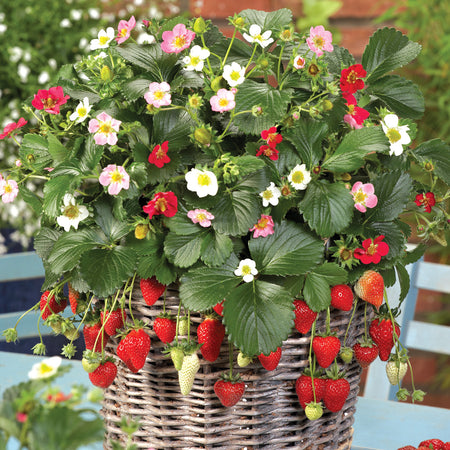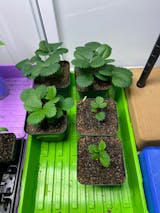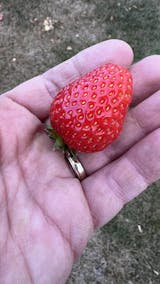RAINBOW TREASURE
Product Description:
| Soil Temp for Germ | 65–75°F |
| Seed Depth | Press into soil lightly |
| Days to Emergence | 2–6 wks |
| Plant Spacing | 8–12" |
| Fertilizer Needs | Medium |
| Minimum Germination | 60% |
| Seeds per Gram | Listed per variety |
| Seed Life | 2 years |
Fragaria vesca
Culture
• Strawberries require fertile, well-drained soil, high in organic matter, with an optimum soil pH of 5.5-6.5
• Prepare beds by deeply digging in a 1 inch layer of compost and 5 pounds of bone meal for 100 square feet
• Plant in raised beds, and cover with plastic or straw mulch to prevent fruit contact with soil, which can cause rot
• Keep beds evenly moist, use drip irrigation if possible, avoid wetting fruit; plants need 1-1 1/2 inches of water per week during the growing season
• Pinch off runners to keep plants productive
• June bearing: Produce berries over a 2-3 week period in early summer
• Everbearing: Produce berries consistently from late spring through fall
Direct Sowing
• Direct seed outside as soon as the soil warms
Transplanting
• Sow indoors 2 months before last frost date
• Strawberry seeds need light to germinate
• Keep moist with a mister
• Up-pot at 3-4 weeks and transplant outside after the danger of frost has passed
Insects & Diseases
• Common pests: Root weevils, aphids, and slugs
• Pest control: Neem oil or Pyrethrin, and baits or traps for slugs
• Common diseases: Mold, mildew, root rot and verticilium wilt
• Disease control: Rotate every 3-4 years with new plants, Greencure®
Strawberry Plants
Fragaria x ananassa
Culture
• Strawberries require fertile, well-drained soil, high in organic matter, with an optimum soil pH of 5.5-6.5
• Prepare beds by deeply digging in a 1 inch layer of compost and 5 pounds of bone meal for 100 square feet
• Plant in raised beds, and cover with plastic or straw mulch to prevent fruit contact with soil, which can cause rot
• Keep beds evenly moist, use drip irrigation if possible, avoid wetting fruit; plants need 1-1 1/2 inches of water per week during the growing season
• Plant 12-15 inches apart in all directions
• Pinch off runners to keep plants productive
• June bearing: Produce berries over a 2-3 week period in early summer
• Everbearing/Day Neutral: Produce berries consistently from late spring through fall
Planting
• Plant in 4 inch pots and hold for a few weeks if soil is not ready when you receive plants
• Dig in 1/4 cup complete fertilizer per plant
• Pinch off blossoms of everbearing varieties until July 1st of the first year
• Pinch off blossoms of June bearing varieties the entire first year
Insects & Diseases
• Common pests: Root weevils, aphids, and slugs
• Pest control: Neem oil or Pyrethrin, and baits or traps for slugs
• Common diseases: Mold, mildew, root rot and verticilium wilt
• Disease control: Rotate every 3-4 years with new plants, Greencure®




